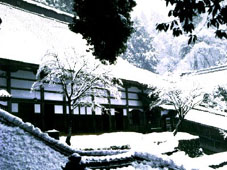

 |
||

|
The Center for Training Zen Priests with
750-year Tradition
 The Zen sect of Buddhism places its foundation of ascetic
practices in silent contemplation called za-zen (Zen meditation). In Zen
meditation, one sits up right, drives any distracting ideas away, and concentrates
his attention to attain the ideal state of supreme enlightenment in a perfect
serenity of mind. Priest Dogen (1200-54) studied the Soto sect, a school
of the Zen sect, in China and introduced it to Japan. And in 1244, he opened
Eiheiji Temple in the mountainous site in Fukui Prefecture as a place for
training and education of Zen monks. Stepping through the main gate into
the temple precincts surrounded by Japanese cedar trees, some of which
are said to be about 600 years old, one can feel stillness and tenseness
which could not be felt in the midst of boisterous and worldly life. The
spirit of Zen taught in Eiheiji Temple has been inherited successively.
As a result, the temple now has 15,000 branch temples and approximately
8 million followers in Japan.
Today in Eiheiji Temple, over a hundred trainee monks from all over the country are working hard every day in training. They wake up at four in the morning and go to bed at nine in the evening. In their waking hours, they lead well-regulated life of Zen meditation, reading sutra, and every-day duties such as cleaning, following austere disciplines. Everything in daily life is part of training. The temple also accepts those who want to temporarily practice Zen meditation only with advanced permission. If accepted, one can experience three to seven days of training that follows the daily schedule of regular trainee monk. Photos: (Top) Hatto (the lecture hall) of Eiheiji Temple (Ministry of Foreign Affairs); (middle) hujaku-mon, one of the gates in the temple premises (Fukui Prefecture). Unauthorized reproduction of the
photos in this page is prohibited.
Related Links: |
|

